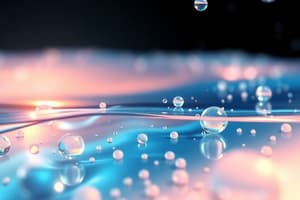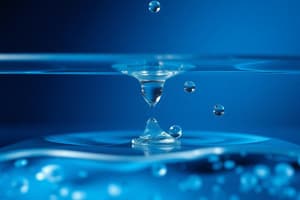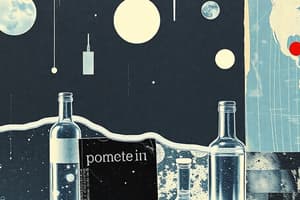Podcast
Questions and Answers
Which statement accurately differentiates between lipophilic and hydrophilic groups in the context of surfactants?
Which statement accurately differentiates between lipophilic and hydrophilic groups in the context of surfactants?
- Lipophilic groups consist of short carbon chains with a high affinity for polar solvents, while hydrophilic groups consist of polar groups with a low affinity for aqueous solvents.
- Lipophilic groups consist of short carbon chains with a low affinity for nonpolar solvents, while hydrophilic groups consist of nonpolar groups with a high affinity for aqueous solvents.
- Lipophilic groups consist of long carbon chains with a low affinity for aqueous solvents, while hydrophilic groups consist of polar groups with a high affinity for polar solvents. (correct)
- Lipophilic groups consist of long carbon chains with a high affinity for aqueous solvents, while hydrophilic groups consist of nonpolar groups with a low affinity for polar solvents.
How does increasing unsaturation in the hydrocarbon chain of a surfactant generally affect the critical micelle concentration (CMC)?
How does increasing unsaturation in the hydrocarbon chain of a surfactant generally affect the critical micelle concentration (CMC)?
- Unsaturation consistently decreases the CMC due to enhanced hydrophobic interactions.
- Unsaturation has no significant impact on CMC because it primarily affects the hydrophilic properties.
- Unsaturation increases the CMC, typically by a factor of 3-4, compared to saturated compounds. (correct)
- Unsaturation initially decreases the CMC but increases it beyond a certain threshold of double bonds.
What is the crucial role of surfactants at liquid interfaces?
What is the crucial role of surfactants at liquid interfaces?
- To increase the surface and interfacial tension by strengthening cohesive forces within the liquid.
- To be adsorbed at the surface of a liquid or at the interface between two liquids, increasing surface or interfacial tension.
- To maintain constant surface and interfacial tension by balancing the cohesive and adhesive forces within the liquid.
- To be adsorbed at the surface of a liquid or at the interface between two liquids, reducing the surface or interfacial tension. (correct)
In the context of temperature's effect on CMC, how do non-ionic surfactants behave differently from ionic surfactants?
In the context of temperature's effect on CMC, how do non-ionic surfactants behave differently from ionic surfactants?
What distinguishes ampholytic surfactants from anionic and cationic surfactants based on their behavior in solution?
What distinguishes ampholytic surfactants from anionic and cationic surfactants based on their behavior in solution?
Which scenario best illustrates the application of surfactants as 'wetting agents' in pharmaceutical formulations?
Which scenario best illustrates the application of surfactants as 'wetting agents' in pharmaceutical formulations?
How do the presence of hydrocarbons influence the Critical Micelle Concentration (CMC) and micelle formation?
How do the presence of hydrocarbons influence the Critical Micelle Concentration (CMC) and micelle formation?
What are the major disadvantages of using non-ionic surfactants in pharmaceutical formulations?
What are the major disadvantages of using non-ionic surfactants in pharmaceutical formulations?
Considering the Hydrophilic-Lipophilic Balance (HLB) system, which scenario would require a surfactant with a higher HLB value?
Considering the Hydrophilic-Lipophilic Balance (HLB) system, which scenario would require a surfactant with a higher HLB value?
How would the addition of a simple electrolyte (salt) to a surfactant solution influence micelle formation?
How would the addition of a simple electrolyte (salt) to a surfactant solution influence micelle formation?
How does the position of a hydrophilic group on a surfactant molecule affect the CMC?
How does the position of a hydrophilic group on a surfactant molecule affect the CMC?
Which statement accurately contrasts crystalline and amorphous solids regarding their microscopic arrangement and macroscopic properties?
Which statement accurately contrasts crystalline and amorphous solids regarding their microscopic arrangement and macroscopic properties?
Under what circumstances is a substance most likely to be found at its triple point on a phase diagram?
Under what circumstances is a substance most likely to be found at its triple point on a phase diagram?
What critical factor determines whether two different crystalline forms of the same chemical substance are classified as enantiotropic or monotropic polymorphs?
What critical factor determines whether two different crystalline forms of the same chemical substance are classified as enantiotropic or monotropic polymorphs?
Which example illustrates a direct pharmaceutical implication of polymorphism related to drug formulation?
Which example illustrates a direct pharmaceutical implication of polymorphism related to drug formulation?
In applying Boyle's Law, what conditions must be maintained to accurately predict volume changes based on pressure variations?
In applying Boyle's Law, what conditions must be maintained to accurately predict volume changes based on pressure variations?
During the phase transition from liquid to gas (vaporization), what happens to the heat applied to the substance?
During the phase transition from liquid to gas (vaporization), what happens to the heat applied to the substance?
Alkyl sulfates and phosphates are examples of anionic surfactants. What functional group do they contain?
Alkyl sulfates and phosphates are examples of anionic surfactants. What functional group do they contain?
Metallic soaps are salts of divalent or trivalent metals with long chain fatty acids. Which example illustrates its characteristics?
Metallic soaps are salts of divalent or trivalent metals with long chain fatty acids. Which example illustrates its characteristics?
Quaternary ammonium compounds like cetrimide and benzalkonium chloride are examples of what?
Quaternary ammonium compounds like cetrimide and benzalkonium chloride are examples of what?
What describes the state of matter known as 'supercritical fluid'?
What describes the state of matter known as 'supercritical fluid'?
In the context of phase diagrams, what is true about the 'critical point'?
In the context of phase diagrams, what is true about the 'critical point'?
How does the structural arrangement contribute to the properties of crystalline solids?
How does the structural arrangement contribute to the properties of crystalline solids?
Select the correct formula about the state of matter depending on the Boyle's Law?
Select the correct formula about the state of matter depending on the Boyle's Law?
Select the correct formula about the state of matter depending on the Charles' Law?
Select the correct formula about the state of matter depending on the Charles' Law?
Select the correct formula about the state of matter depending on the Ideal Gas Law?
Select the correct formula about the state of matter depending on the Ideal Gas Law?
A polymorph of a drug is more stable than othe polymorphs of the same drug when:
A polymorph of a drug is more stable than othe polymorphs of the same drug when:
Which type of crystal solvates are more useful in the pharmaceutical industry?
Which type of crystal solvates are more useful in the pharmaceutical industry?
What makes triethanolamine oleate a good example for Amine soaps?
What makes triethanolamine oleate a good example for Amine soaps?
What happens with heat in each phase change process?
What happens with heat in each phase change process?
What unit cells crystal system does 'lodine' belong to?
What unit cells crystal system does 'lodine' belong to?
Select the best known example, for the medical field, where crystal habits may be difficult to inject in suspension form or to formulate as tablets:
Select the best known example, for the medical field, where crystal habits may be difficult to inject in suspension form or to formulate as tablets:
In a scenario where you are formulating an ophthalmic solution, why is it crucial to understand polymorphism?
In a scenario where you are formulating an ophthalmic solution, why is it crucial to understand polymorphism?
Non-ionic surfactants are the largest group used in pharmaceutical preparations. Which is the benefit of them?
Non-ionic surfactants are the largest group used in pharmaceutical preparations. Which is the benefit of them?
Which pharmaceutical application describes surfactants adsorbed at the solid/liquid interface between powder particles and the solvent?
Which pharmaceutical application describes surfactants adsorbed at the solid/liquid interface between powder particles and the solvent?
Ampholytic surfactants change their ion character in some conditions. Select where this occurs:
Ampholytic surfactants change their ion character in some conditions. Select where this occurs:
Flashcards
Surfactants or surface active agents (SAA)
Surfactants or surface active agents (SAA)
Molecules adsorbed at liquid surfaces, reducing surface or interfacial tension.
Amphiphil
Amphiphil
Contains both polar and nonpolar groups, contributing to its affinity for both aqueous and non-aqueous solutions.
Hydrophilic-Lipophilic Balance (HLB)
Hydrophilic-Lipophilic Balance (HLB)
System that gives the balance between the hydrophilic and lipophilic nature of surfactants.
Anionic Surfactant
Anionic Surfactant
Signup and view all the flashcards
Cationic Surfactant
Cationic Surfactant
Signup and view all the flashcards
Ampholytic (Amphoteric) Surfactant
Ampholytic (Amphoteric) Surfactant
Signup and view all the flashcards
Non-ionic Surfactant
Non-ionic Surfactant
Signup and view all the flashcards
Micelle Formation
Micelle Formation
Signup and view all the flashcards
Critical Micelle Concentration (CMC)
Critical Micelle Concentration (CMC)
Signup and view all the flashcards
Chain Length
Chain Length
Signup and view all the flashcards
Simple Electrolytes
Simple Electrolytes
Signup and view all the flashcards
Alcohols
Alcohols
Signup and view all the flashcards
Hydrocarbons
Hydrocarbons
Signup and view all the flashcards
Antimicrobials
Antimicrobials
Signup and view all the flashcards
Expectorants
Expectorants
Signup and view all the flashcards
Solubilizing agents
Solubilizing agents
Signup and view all the flashcards
Wetting Agents
Wetting Agents
Signup and view all the flashcards
Flocculating Agents
Flocculating Agents
Signup and view all the flashcards
Emulsifying Agents
Emulsifying Agents
Signup and view all the flashcards
Additives in Semisolid Preparations
Additives in Semisolid Preparations
Signup and view all the flashcards
Matter
Matter
Signup and view all the flashcards
Solid State
Solid State
Signup and view all the flashcards
Liquid State
Liquid State
Signup and view all the flashcards
Gas State
Gas State
Signup and view all the flashcards
Plasma State
Plasma State
Signup and view all the flashcards
Gas Molecular Motion
Gas Molecular Motion
Signup and view all the flashcards
Liquid Molecular Motion
Liquid Molecular Motion
Signup and view all the flashcards
Solid Molecular Motion
Solid Molecular Motion
Signup and view all the flashcards
Boyle's Law
Boyle's Law
Signup and view all the flashcards
Charles' Law
Charles' Law
Signup and view all the flashcards
EACH ADDITION OF ENERGY CREATES A CHANGE IN STATE
EACH ADDITION OF ENERGY CREATES A CHANGE IN STATE
Signup and view all the flashcards
Melting
Melting
Signup and view all the flashcards
Freezing
Freezing
Signup and view all the flashcards
Vaporization
Vaporization
Signup and view all the flashcards
Condensation
Condensation
Signup and view all the flashcards
Sublimation
Sublimation
Signup and view all the flashcards
Gas Deposition
Gas Deposition
Signup and view all the flashcards
Phase Diagram
Phase Diagram
Signup and view all the flashcards
Triple Point
Triple Point
Signup and view all the flashcards
Critical Point
Critical Point
Signup and view all the flashcards
Study Notes
Surface Active Agents (SAA) / Surfactants
- Solutes or molecules get adsorbed at a liquid's surface or the interface between two liquids
- They reduce surface or interfacial tension
Composition of Soluble Surfactants
- Lipophilic/hydrophobic groups consist of long carbon chains with low affinity for aqueous solvents
- Hydrophilic/lipophobic groups consist of polar groups like -COOH or -OH with affinity for polar solvents
- Surfactants with polar and nonpolar groups that have affinity for both aqueous and non-aqueous solvents are termed "amphiphils"
HLB System Formula Definition
- Balance between hydrophilic and lipophilic nature of surfactants is given by the HLB system
- The HLB system consists of an arbitrary scale of values used to describe surfactants
- Formula: HLB = 20 x (Mh / Mt)
- Mh is the molecular weight of the hydrophilic group, Mt is the molecular weight of the whole molecule
- Each surfactant in the HLB system has a number between 1 and 20, showing the relative proportions of lipophilic and hydrophilic parts of the molecule
- Higher number means more hydrophilic
- Lower number means more lipophilic
HLB Values Example
- HLB value of Tween 20 (polyoxyethylene (20) sorbitan monolaurate) calculation:
- HLB = 20 x (1044 / 1226) = 17
- HLB Calculation for Merj 49 (polyoxyethylene)21 stearate knowing that the total m.w is 1024 and Oxyethylene m.w is 44 Da:
- HLB = 20 x (924 / 1024) = 18
HLB Scale Surfactant Uses
- HLB value is used to determine different uses for each surfactant
- HLB values and their uses are
- 1: Oleic acid
- 3.8: Glyceryl monostearate
- 4.3:Sorbitan monooleate
- 4.7:Sorbitan monostearate
- 6.7:Sorbitan monopalmitate
- 8: Glyceryl monostearate
- 8.6: Gum acacia
- 12: Sorbitan monolaurate
- 15: Triethanolamine oleate
- 16: polyoxyethylene sorbitan monooleate
- 17: Polyoxyethylene sorbitan monolaurate
- 40 Sodium lauryl sulphate
Classification of Surfactants
- Anionic
- Cationic
- Nonionic
- Amphoteric
Anionic Surfactants
- Release long chain anion upon dissociation, giving surface activity
- These feature a general formula of sulfate (OSO3-) while the cationic part is inactive
- Anionic surfactants are unsuitable for oral use due to unpleasant taste and irritant action
Anionic Examples
- Alkali soaps: Unstable below pH 10, incompatible with acids like potassium and sodium stearate
- Amine soaps: Triethanolamine oleate produced from reactions of amines with fatty acids
- Metallic soaps: Salts of divalent or trivalent metals with long-chain fatty acids
- Alkyl sulfates and phosphates: Esters formed by the reaction of fatty alcohols with sulfuric or phosphoric acid, e.g., sodium lauryl sulfate
- Alkyl sulfonate: Includes Dioctyl sodium sulfo succinate
Cationic Surfactants
- These must be ionized or dissociated to be effective
- Form +ve cations in aqueous solutions, providing surface activity with a general formula of trimethyl ammonium N(CH3)3+
- They're used as antiseptic, emulsifiers, and preservatives
Cationic examples
- Quaternary ammonium compounds like cetrimide (cetyl trimethyl ammonium bromide) and benzalkonium chloride (benzyl trimethyl ammonium chloride)
Ampholytic (Amphoteric) Surfactants
- Substances whose ionic characters depend on the pH of the system
- Below a certain pH (acidic) → cation, above the defined pH (alkaline) →anion
- At intermidiate pH → zwitterions
- Lecithin and N-dodecyl-alanine are examples
Non-Ionic Surfactants
- Constitute biggest group used in pharmaceutical preparations
- Advantages: compatible with anionic and cationic S.A.A., resist pH changes, resist effects of electrolytes, less irritant
- Disadvantage: Tend to inactivate preservation of phenolic or carboxylic groups
- Examples: Brij & merj 2, Spans, Tweens, Macrogol esters or polyethylene glycol (PEG), Glycerol monostearate
Micelle Formation
- Important property of surfactants where they have the capacity to aggregate in solution
- The aggregation process depends on the surfactants and condition of the system they are dissolved in
- Abrupt change in physicochemical properties is seen when specific concentration is exceeded will result in formation of oriented colloidal aggregates
How Micelles are Formed
- Surfactant molecules (monomers) orient at liquid-air interface upon addition of surfactants to water
- Monomers adsorbed at the surface become crowded with more surfactants until the interface is occupied. The surfactant is compressed at the surface and monomers become crowded
- Molecules of surfactant aggregate into micelles with further surfactant additions.
Micelle Shapes and Progression
- Monomers --> Spherical Micelle --> Cylindrical Micelle --> Lamellar Micelle
- Changes in surfactant concentration impacts micelle shape and structure
Why Micelles Are Formed
- To achieve a state of minimum free energy (more stability).
- To remove hydrophobic group form aqueous solution.
Critical Micelle Concentration (CMC)
- The concentration at which micelles are formed
- Surfactant concentration above which it migrates to the bulk, forms micelles and shows minimum surface tension value
- Surface tension goes down until CMC, at which point micelles form.
Factors Affecting CMC
- Molecular structure of surface active agent
- Hydrocarbon chain (hydrophobic part)
- Chain length: As chain length increases, micelle size increases, so CMC decreases
- Branched hydrocarbon chain: Branching increases CMC since chain must come together in the micelle
- Unsaturation: CMC increases by 3-4x with double bonds present
- Hydrocarbon chain (hydrophobic part)
Factors Affecting CMC, Hydrophilic Group
- Hydrophilic group:
- Type of hydrophilic group: Complete ionic dissociation leads to small effect on CMC
- Number of hydrophilic groups: CMC increases in solubility as the number increases
- Position of hydrophilic group: CMC increases when polar groups move from the terminal position to middle
CMC Additives
- Electrolytes: Addition of salts decreases CMC
- Alcohols: Decreases CMC facilitating micelle formation
- Hydrocarbons: Decreases CMC, facilitates micelle formation
- Other surfactants: Decreases or increases CMC
Temperature Effect of CMC
- Non-ionic surfactants: The CMC value first decreases with increasing temperature to a certain minimum, then increases with further temperature increase
- As temperature increases, hydrogen bonding weakens which facilitates micellization (lowers CMC)
- Rising temperature distorts water structure reducing micellization (higher CMC)
- Overall CMC increase or decrease relies on temperature related effects
- Ionic surfactants: Temperature has a small effect on the micelle property
Medical Applications of Surface Active Agents
- Antimicrobials: Quaternary ammonium compounds like benzalkonium chloride are antibacterial, used as disinfectants for instruments, and as antimicrobial agents in eye drops and creams
- Expectorants: Reduces the viscosity of bronchial mucus through inhalation of sprays with surfactants in cases of acute and chronic respiratory infections
- Cleansing agents: Surfactants have detergent properties
Pharmaceutical Applications of Surface Active Agents
- Solubilizing agents: SAAs extensively used as solubilizing agents for poorly soluble drugs like oil soluble vitamins, volatile oils, and hormones
- Also used as solubilizers for disinfectants like cresol or chloroxylenol
- This increases disinfectant property due to permeability changes in the cell membrane of microoganisms
- Wetting agents: Surfactants adsorbed at solid/liquid interface between powder particles and solvent increases affinity of hydrophobic powder of water
- Flocculating agents: Surfactants enable controlled flocculation for suspension powder particles
- Emulsifying agents: Reduce interfacial tension between oil and water phases by forming stable interfacial film
- Additives in semisolid preparations: Modify release characteristic of incorporated drug increasing skin absorption
- For example: Tween and Span
State of Matter
- State depends on temperature and pressure of a given substance
- Five states of matter: solid, liquid, gas, plasma, super critical fluid (state of matter in which the matter behaves like a fluid without viscosity and with infinite thermal conductivity.)
Solids
- Particles are tightly packed, vibrating in a fixed position.
- Solids have a definite shape and a definite volume
Liquids
- The particles are tightly packed, but far enough apart to slide over one another to flow
- Liquids have an indefinite shape and a definite volume
Gas
- Particles of gases are very far apart and move freely
- Gases have an indefinite shape and indefinite volume
Plasma
- Plasma is an electrically charged gas
- Plasma particles have an electrical charge, and are affected by electrical and magnetic fields
Properties Differentials Across States
| Property | Gas | Liquids | Solids |
|---|---|---|---|
| General | definite mass but no definite shape and volume | definite mass, volume but no definite shape | definite mass, volume and shape |
| Forces | Almost negligible | weak | strong |
| Density | lowest | low | highest |
| Motion | large rotatory, vibratory and translatory motions | vibratory and translatory motion | No translatory and rotatory motion |
| Kinetic Energy | High | Moderate | Negligible |
| Thermal Expansion | Highest | High | Least |
| Compression | High | Low | Least |
| Intermixing | Spontaneous | Slow | Least |
| Pressure | Exert pressure on the walls | Negligible | Negligible |
Boyle's Law
- States for a fixed amount of gas at constant temperature, the volume of the gas increases as its pressure decreases
- Formula: P1V1 = P2V2
Charles' Law
- States that for a fixed amount of gas at a constant pressure, the volume of the gas increases as the temperature of the gas increases.
- Formula: V1/T1 = V2/T2
Ideal Gas Law
- Combines Boyle's and Charles' laws forming a single equation
- PV=nRT, where P is pressure, V is volume, n is number of moles, R is universal gas constant= 8.314 J mol-1k-1 and T is temperature
- One mole of substance contains 6.023x 10^23 particles of that substance
Phase Changes
- The transfers between solid, liquid, gas, and plasma
- Transfers between the states are solid to liquid (melting), liquid to solid (freezing), solid to gas (sublimation), liquid to gas (vaporization), gas to liquid (condensation) and gas to solid (deposition)
- These transfers increase (melting) or decrease (freezing) heat within the system
Heat Directionalities of Phase Changes
- Heat is required for: melting (solid → liquid), vaporization (liquid → vapour), sublimation: solid → vapour
- Heat is released by: condensation (vapour → liquid), freezing (liquid → solid), and deposition (vapour → solid)
Phase Diagram
- Shows what phases exists at equilibrium
- Allows to expect phase transformations expected when one changes parameters of the system
- A relationship between the temp, composition and quantities of phases at equilibrium
- Triple point: The point at which all the three curves meet. Here, the substance will be in a state of equilibrium between the three states and minor variations cause it to shift between them.
- Critical point: the point at which the Vaporization curve "ends". The pressure at this point is called the "critical pressure" and the temperature, the "critical temperature."
Crystalline and Amorphous Solids
- Solids are split into these two types
- Crystalline Solids: their structural units are arranged in fixed geometric patterns or lattices, exhibit a definite shape and an orderly arrangement of units, and have a sharp melting point (e.g.- quartz, sugar, table salt etc)
- Amorphous Solids: their structural units of are arranged in a random manner, do not have a sharp melting point, generally are more soluble than crystalline solids (e.g.- glass, woods, plastics, rubber etc)
Crystal Structure Attributes
- Constructed from repeating units known as unit cells
- Specific crystal unit cells share a size and number of molecules/ions arranged in the same way
- Has cubic, tetragonal, orthorhombic, rhombohedral, monoclinic, triclinic and hexagonal cells
Seven Basic Unit Cells
- Crystal forms divided into basic 7 units based on symmetry
- Simple cubic NaCl
- Tetragonal Urea
- Orthohombic Iodine
- Rhombohedral Quartz
- Monoclinic Sucrose
- Triclinic Boric Acid
- Hexagonal Iodoform and Beryl
Polymorphism Definition
- Polymorphism is the ability of a substance to exist in more than one crystal structure
- Also the ability of any compound or element to crystallize as one or more distinct crystal species with different internal lattice.
- Polymorphs of the same drug show different X-ray diffraction patterns, DSC, IR, may have different melting points, solubilities and bioavilability & also usually exist in different habits
Polymorph Stability
- The polymorphic form with the lowest free energy will be the most stable.
- The other polymorphs will tend to transform into
Crystal Habit Influence
- Impacts the ability to inject a suspension containing a drug in crystal form,
- Also impacts the flow properties and compressibility of a drug
- Crystal habit depends on conditions of crystallization that include solvent used, temperature, the concentration and presence of impurities and surfactants
- Conditions increase crystal growth through absorbption onto growing faces
Polymorphism Types
- Polymorph 1- Salt is a counter ion, Solvate is a solvent, Hydrate is water, Co-crystal is an excipient/API
- Polymorph 2- API is an excipient
- Enantiotropic has stable ↔ Metastable and reversible change, is affect by temperature, Moisture and grinding and has an examplenof sulphar
- Monotropic (Metastable) has Metastable → stable and irreversible change, not has affected by temp. moisture and grounding and has glyceryl stearate as an example.
Polymorphism Influencing Factors
- Temperature
- Pressure
- Solvents
- Agitation
- Milling
- Rate of crystallisation
Pharmaceutical Implications
- Formulation problems include: Polymorphs with specific crystal habits are hard to inject in suspensions or formulate as tablets
- Transformation changes lead to changes crystal size causing caking
- Crystal growth results in gritty creams
- Changes can cause produce different and unacceptable results
- Impacts Bioavailability Differences, crystal and Pseudopolymorphic solvates,
- Impacts solid form properties:
- Dissolution
- Stability
- Processing
Studying That Suits You
Use AI to generate personalized quizzes and flashcards to suit your learning preferences.





